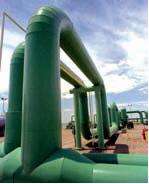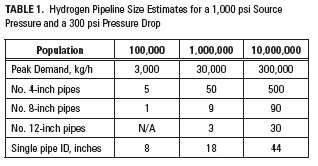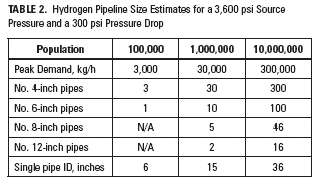Hydrogen pipeline transport
Hydrogen pipeline transport is a transportation of hydrogen through a pipe as part of the hydrogen infrastructure.

History
- 1938 - Rhine-Ruhr The first 240 km (150 mi) hydrogen pipes that are constructed of regular pipe steel, compressed hydrogen pressure 210–20 bars (21,000–2,000 kPa), diameter 250–300 millimetres (9.8–11.8 in). Still in operation.[1][2]
- 1973 – 30 km (19 mi) pipeline in Isbergues, France.[3]
- 1985 - Extension of the pipeline from Isbergues to Zeebrugge
- 1997 - Connection of the pipeline to Rotterdam
- 1997 - 2000: Development of two hydrogen networks, one near Corpus Christi, Texas, and one between Freeport and Texas City.
- 2009 - 150 mi (240 km) extension of the pipeline from Plaquemine to Chalmette.[4]
Economics

Hydrogen pipeline transport is used to transport hydrogen from the point of production or delivery to the point of demand. Although hydrogen pipeline transport is technologically mature,[5][6] and the transport costs are similar to those of CNG,[7] most hydrogen is produced in the place of demand, with an industrial production facility every 50 to 100 miles (80 to 161 km)[8]
Piping
Hydrogen has problems with both hydrogen embrittlement and corrosion. Hydrogen has an active electron, and therefore behaves somewhat like a halogen.[9] For this reason, hydrogen pipes have to resist corrosion. The problem is compounded because hydrogen can easily migrate into the crystal structure of most metals.[9] For process metal piping at pressures up to 7,000 psi (48 MPa), high-purity stainless steel piping with a maximum hardness of 80 HRB is preferred.[10]
Composite pipes are assessed like:
- carbon fiber structure with fiberglass overlay .
- perfluoroalkoxy (PFA, MFA).
- polytetrafluoroethylene (PTFE)
- fluorinated ethylene propylene (FEP) .
- carbon-fiber-reinforced polymers (FRP)
Fiber-Reinforced Polymer pipelines (or FRP pipeline) and reinforced thermoplastic pipes are researched.[11][12][13][14] Currently, Pipelife Nederland B.V., with its SoluForce brand name, is the only RTP producer that sells a pipe that is certified for hydrogen applications at an operating pressure of 42 bar. First application of the SoluForce Hydrogen solution will be at Groningen Seaports, where four kilometres (2.5 miles) of SoluForce infrastructure will be installed later this year. This infrastructure will distribute green hydrogen produced by wind mills in the North sea to companies in the chemical and industrial sectors in the Eemshaven.[15]
Infrastructure

- 2004 - USA - 900 mi (1,400 km) of low pressure hydrogen pipelines[16][17]
- 2004 - Europe - 1,500 km (930 mi) of low pressure hydrogen pipelines.[18]
- 2020 - Europe - 4 km (2.5 mi) of low pressure spoolable reinforced thermoplastic pipe [15]
Gallery
 Hydrogen pipelines
Hydrogen pipelines
See also
- Guided rotor compressor
- HCNG
- Hydrogen economy
- Hydrogen infrastructure
- Hydrogen leak testing
- Hydrogen station
- Hydrogen turboexpander-generator
- Pipeline transport
- Plastic pressure pipe systems
- Timeline of hydrogen technologies
- Tubing (material)
References
- "The Technological Steps of Hydrogen Introduction - pag 24" (PDF). Archived from the original (PDF) on 2008-10-29. Retrieved 2008-08-29.
- rise.org - Pipelines
- 2006 - vector of clean energy - pag 15 Archived 2008-10-14 at the Wayback Machine
- Hydrogen Pipeline Extension Strengthens Gulf Coast Network Archived 2009-03-16 at the Wayback Machine
- 2005 DOE Hydrogen Pipeline Working Group Workshop Archived 2016-03-03 at the Wayback Machine
- Natural gas pipelines for hydrogen transportation
- 2006 - Compressorless Hydrogen Transmission Pipelines Deliver Large-scale Stranded Renewable Energy at Competitive Cost - 16th World Hydrogen Energy Conference, Lyon, 13–16 June 2006 Archived 2012-02-10 at the Wayback Machine
- Every 50 to 100 miles Archived 2007-08-20 at the Wayback Machine
- Stuart Island Energy Initiative Website Archived 2019-06-06 at the Wayback Machine Accessed 2010-10-13
- Idaho national Engineering Laboratory Recommendations for Piping for Gaseous Hydrogen Archived 2012-09-16 at Archive-It Accessed 2010-10-13
- 2007 - Fiber Fiber-Reinforced Polymer Pipelines
- "NEW, COMPOSITE POLYMERIC/METALLIC MATERIALS AND DESIGNS FOR HYDROGEN PIPELINES" (PDF). Archived from the original (PDF) on 2008-10-08. Retrieved 2008-08-29.
- 2006 FRP Hydrogen Pipelines
- "Lifetime Simulation Composite & Multilayer Pipelines". Archived from the original on 2012-02-07. Retrieved 2009-11-02.
- "SoluForce Certified for Hydrogen Applications". SoluForce. 29 January 2020.
- 2004 USA pipelines Archived 2010-05-27 at the Wayback Machine
- 2008 Argonne National Laboratory report
- 2004 EU pipelines